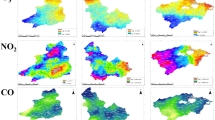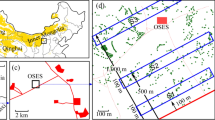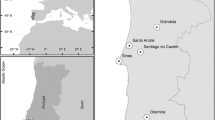Abstract
Diversity and abundance of five species of epiphytic lichens were assessed in Kolkata, India. Significant correlation between abundance of lichen species and volume of vehicular traffic suggests atmospheric pollution load in urban region. Parmelia caperata (L.) Ach. and Graphis scripta (L.) Ach. exhibited higher abundance among the five species studied indicating their higher level of tolerance to air pollution. Significant correlations (p < 0.05) between levels of heavy traffic and both diversity and abundance of all lichen species were also observed. These findings indicate a potential threat to the survival of the lichen communities in Kolkata. Study further deals with quantifying the effectiveness of lichen species in accumulating metallic elements like Pb, Zn, and Cu. This was achieved by analyzing the most abundant lichen species (Parmelia caperata) collected from nine different sites in winter, summer, and monsoon seasons. Metal content in lichen thalli, as analyzed by AAS, shows their elevated levels with the order Pb > Zn > Cu. Relationship between metal content and volume of vehicular traffic suggests that co-associated, metallic elements are emitted as vehicle-derived pollutants as well as diffuse industrial emissions. Accumulation of these metals is higher in winter which is proportionate with the higher degree of metabolism due to higher humidity in this season. Study also demonstrates the dynamics of metal uptake by the lichen at different sites influenced with different degree of vehicular traffic. Overall results confirm suitability of lichen with their potential role in sequestration of atmospheric metal contamination.






Similar content being viewed by others
References
Adamo P, Bargagli R, Giordano S, Modenesi P, Monaci F, Pittao E, Spagnuolo V, Tretiach M (2008) Natural and pre-treatments induced variability in the chemical composition and morphology of lichens and mosses selected for active monitoring of airborne elements. Environ Pollut 152:11–19
Awasthi DD (1988) A key to the macro lichens of India and Nepal. J Hattori Bot Lab 65:207–302
Awasthi DD (1991) A key to the microlichens of India, Nepal and Sri Lanka. J Cramer, Berlin & Stuttgart
Backor M, Vaczi P (2002) Copper tolerance in the lichen photobiont Trebouxia erici (Chlorophyta). Environ Exp Bot 48:11–20
Bajpai R, Upreti DK (2012) Accumulation and toxic effect of arsenic and other heavy metals in contaminated area of WestBengal, India, in the lichen Pyxine cocoes (Sw.) Nyl. Ecotoxicol Environ Safety 83:63–70
Bajpai R, Upreti DK, Nayaka S, Kumari B (2010a) Biodiversity, bioaccumulation and physiological changes in lichens growing in the vicinity of coal-based thermal power plant of Raebareli district, north India. J Hazard Mater 174:429–436
Bajpai R, Upreti DK, Dwivedi SK (2010b) Passive monitoring of atmospheric heavy metals in a historical city of central India by Lepraria lobificans Nyl. Environ Monit Assess 66:477–484
Bajpai R, Mishra GK, Mohabe S, Upreti DK, Nayaka S (2011) Determination of atmospheric heavy metals using two lichen species in Katni and Rewa cities, India. J Environ Biol 32:195–199
Baptista MS, Teresa M, Vasconcelos SD, Cabral JP, Freitas MC, Pacheco AMG (2008) Copper, nickel and lead in lichen and tree bark transplants over different periods of time. Environ Pollut 151:408–413
Bargagli R, Monaci F, Borghini F, Bravi F, Agnorelli C (2002) Mosses and lichens as biomonitors of trace metals. A comparison study on Hypnum cupressiforme and Parmelia caperata in a former mining district in Italy. Environ Pollut 116:279–287
Bennett JP, Wetmore CM (1999) Changes in element contents of selected lichens over 11 years in northern Minnesota, USA. Environ Exp Bot 41:75–82
Blasco M, Domeno C, Lopez P, Nerın C (2011) Behaviour of different lichen species as biomonitors of air pollution by PAHs in natural ecosystems. J Environ Monit 13:2588
Brawn K, Odgen JG (1976) Lichen diversity and abundance as affected by traffic volume in an urban environment. Urban Ecol 2:235–244
Clair SB, Clair LL, Mangelson NF, Weber DJ (2002) Influence of growth form on the accumulation of airborne copper by lichens. Atmosph Environ 36:5637–5644
Cloquet C, Carigan J, Libourel G (2006) Isotopic composition of Zn and Pb atmospheric depositions in an urban/periurban area of northeastern France. Environ Sci Technol 40:6594–6600
Conti ME, Tudino MB, Stripeikis J, Cecchetti G (2004) Heavy metal accumulation in the lichen Evernia Prunastri transplanted at urban, rural and industrial sites in Central Italy. J Atmos Chem 49:83–94
Cristofolini F, Giordani P, Gottardini E, Modenesi P (2008) The response of epiphytic lichens to air pollution and subsets of ecological predictors: a case study from the Italian Prealps. Environ Pollut 151:308–317
Das TM, Guha N, Majumdar S, Samim KA, Roy S, Das G, Das AK (1986) Studies on plant responses to air pollution: occurrence of lichens in relation to traffic load of Calcutta city. Indian Biol 18:26–29
Dzubaj A, Bačkor M, Tomko J, Peli E, Tuba Z (2008) Tolerance of the lichen Xanthoria parietina (L.) Th. Fr. to metal stress. Ecotoxicol Environ Safety 70:319–326
Ellis C, Coppins B (2010) Partitioning the role of climate, pollution and old-growth woodland in the composition and richness of lichen epiphytes in Scotland. Lichenologist 42:601–614
Garty J (1993) Lichens as biomonitors for heavy metal pollution. In: Markert B (ed) Plants as biomonitors. VCH, Weinheim, pp 193–264
Garty J (2001) Biomonitoring atmospheric heavy metals with lichens: theory and application. Crit Rev Plant Sc 20:309–371
Godinho RM, Verburg TG, Freitas MC, Wolterbeek HT (2009) Accumulation of trace elements in the peripheral and central parts of two species of epiphytic lichens transplanted to a polluted site in Portugal. Environ Pollut 157:102–109
Hauck M (2011) Site factors controlling epiphytic lichen abundance in northern coniferous forests. Flora 206:81–90
Kar S, Nath B, Samal AC, Santra SC (2006) Arsenic in urban particulates—a case study in Kolkata metropolitan area. Curr Sci 90:158–160
Kar S, Maity JP, Samal AC, Santra SC (2010) Metallic components of traffic induced urban aerosol. Environ Monit Assess 168:561–574
Kar S, Maity JP, Samal AC, Santra SC, Jean JS, Bundschuh J (2013) Deposition and uptake of metals in urban canopy: atmospheric arsenic sequestration. J Hazard Mat (http://dx.doi.org/10.1016/j.jhazmat.2012.12.048)
Karar K, Gupta AK, Kumar A, Biswas AK (2006) Characterization and identification of the sources of Cr, Zn, Pb, Cd, Ni, Mn and Fe in PM10 particulates at the two sites of Kolkata. India Environ Monit Assess 120:347–360
Koz B, Celik N, Cevik U (2010) Biomonitoring of heavy metals by epiphytic lichens species in Black Sea region of Turkey. Ecolog Indicat 10:762–765
Kumar E, Bonalberti L, Piccoli F, Garasto G (1991) Lichen as monitors of air pollution. Grana 30:48–50
Loppi S, Nelli L, Ancora S, Bargagli R (1997) Accumulation of trace elements in the peripherial and central parts of a foliose thallus. Bryologist 100:251–253
Loppi S, Frati L, Paoli L, Bigagli V, Rossetti C, Bruscoli C, Corsini A (2004) Biodiversity of epiphytic lichens and heavy metal contents of Flavoparmelia caperata thalli as indicators of temporal variations of air pollution in the town of Montecatini Terme (central Italy). Sci Total Environ 326:113–122
Majumdar S, Ram SS, Jana NK, Santra S, Chakraborty A, Sudarshan M (2009) Accumulation of minor and trace elements in lichens in and around Kolkata, India: an application of X-ray fluorescence technique to air pollution monitoring. X-Ray Spectrom 38:469–473
Majumder S, Mishra D, Ram SS, Jana NK, Santra SC, Sudarshan M, Chakraborty A (2012) Physiological and chemical response of the lichen, Flavoparmelia caperata (L.) Hale, to the urban environment of Kolkata, India. Environ Sci Pollut Res. doi:10.1007/s11356-012-1224-2
Minganti V, Capelli R, Drava G, De Pellegrini R, Brunialti G, Giordani P, Modenesi P (2003) Biomonitoring of trace metals by different species of lichens (Parmelia) in north-west Italy. J Atmosph Chem 45:219–229
Paoli L, Pisani T, Guttova A, Sardella G, Loppi S (2011) Physiological and chemical response of lichens transplanted in and around an industrial area of south Italy: relationship with the lichen diversity. Ecotoxicol Environ Safety 74:650–657
Phillips EA (1959) Methods of vegetation study. Holt, Rinehart and Winston Inc, New York
Rizzio E, Bergamaschi MG, Valcuvia MG, Profumo A, Gallorini M (2001) Trace element determination in lichens and in the airborne particulate matter for the evaluation of the atmospheric pollution in a region of northern Italy. Environ Int 26:543–549
Russellflegal A, Gallon C, Hibdon S, Kuspa Z, Laporte A (2010) Declinings but persistents atmospheric contamination in central California from the resuspension of historic leaded gasoline emissions as recorded in the lace lichen (Ramalina menziesii Taylor) from 1892 to 2006. Environ Sci Technol 44:5613–5618
Scheidegger C, Werth S (2009) Conservation strategies for lichens: insights from population biology. Fungal Biol Rev 23:55–66
Simonetti A, Gariepy C, Carignan J (2003) Tracing sources atmospheric pollution in western Canada using the Pb isotopic composition and heavy metal abundance of epiphytic lichens. Atmosph Environ 37:2853–2865
Uijily ME, Kumaraguru AK (2004) Accumulation of heavy metals in some species of lichens in south Tamilnadu, India. J Environ Sci Eng 46:186–193
Upreti DK (1996) Studies in Indian ethnolichenology—an overview. In: Jain SK (ed) Ethnobiology in human welfare. Deep Publications, New Delhi, pp 413–414
Upreti DK, Nayaka S, Bajpai A (2005) Do lichens still grow in Kolkata city? Curr Sc 88:338–339
Acknowledgments
Authors would like to thank Department of Environmental Science, University of Kalyani for providing research and experimental facilities.
Author information
Authors and Affiliations
Corresponding author
Rights and permissions
About this article
Cite this article
Kar, S., Samal, A.C., Maity, J.P. et al. Diversity of epiphytic lichens and their role in sequestration of atmospheric metals. Int. J. Environ. Sci. Technol. 11, 899–908 (2014). https://doi.org/10.1007/s13762-013-0270-8
Received:
Revised:
Accepted:
Published:
Issue Date:
DOI: https://doi.org/10.1007/s13762-013-0270-8




